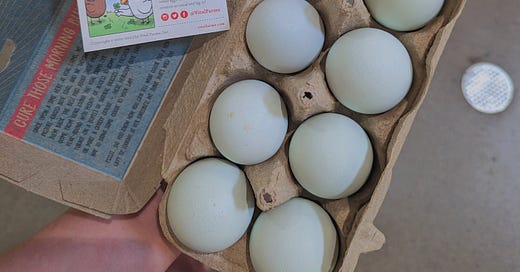The allure of blue eggs: exploring "excuseflation" and "premiumization" in the food industry
From blue eggs to restorative eggs, there seems to be no limit to the number of different kinds of eggs that can be sold.
As I’m sure you’ve noticed, eggs have gotten expensive.
In March 2021, the average price of a dozen large grade-A eggs in America was $1.62 and in March 2023 it had risen to $3.44 (after coming down from a peak price of $4.82 in January 2023).
According to the American Egg Board, the avian flu and inflation’s impact on the cost of labor, transportation, etc. are to blame for the higher prices.
As a consumer, that story makes sense…until you also hear that the country’s largest egg producer, Cal-Maine, had zero birds test positive for avian flu and managed to bring in 718% more profits in the first quarter of 2023 than they did during the same period in 2022.
Sen. Elizabeth Warren (D-Mass.) and Rep. Katie Porter (D-Ca.) addressed concerns about corporate greed in a letter to Cal-Maine’s CEO, stating, “American families working to put food on the table deserve to know whether the increased prices they are paying for eggs represent a legitimate response to reduced supply or out-of-control corporate greed.”
In a Today, Explained podcast episode “Why stuff isn’t getting cheaper” they dove into the concepts of “excuseflation” and “premiumization”, both of which can help to add additional layers of insight into the high cost of eggs:
“Excuseflation” refers to when companies exploit issues like supply chain problems and geopolitical conflicts in order to raise prices beyond the inflation rate, and see their profits go up. When those issues go away, they tend not to lower prices in response.
“Premiumization” refers to how brands can make products appear superior or special in some kind of way, thus encouraging customers to pay more for them.1
One example of premiumization in the egg industry2 is Vital Farms True Blues.
Something about these baby blue shells is beautiful, perhaps it’s related to the rarity of the color blue in nature that makes our eyes widen at the sight of them.
The cost of one dozen Vital Farms blue eggs ranges around $10, while their brown counterpart - following the same farming practices - is around $8 per dozen.
The chickens that lay the blue eggs are called Azur hens.
Vital Farms notes on its website, “Though they look different than our classic, brown-feathered ladies, these girls are tended with the same love, care, and outdoor access year-round on rotated pastures.”3
In short, while these eggs may look more appealing, they’re not superior to their brown counterpart in terms of quality, nutrition, farming practices, taste, or any other metric…apart from their appearance.
Their existence serves the purpose of providing us with another tier4 to strive for, in the same way we crave the latest iPhone. When you pass up on the blue eggs for brown or white ones, it may leave you wondering if you haven’t quite ~made it~ yet in life.
But there’s always a more premium, expensive version of everything. Ultimately, it is our decision where to draw the line.
Leave a Comment:
What foods are you willing to pay a premium for that you think are worth the extra money?
Do you think you’ve fallen for “premiumization” in any of your food purchases?
Read more about this in the New York Times article “Is the Entire Economy Gentrifying?”
Another example is Consider Pastures, which my local Whole Foods seems to have stopped carrying. They’re wrapped in the most beautiful teal box that makes you wonder if a dozen eggs might serve as a nice birthday gift for someone. They’re a sister brand to Pete & Gerry’s Eggs.
What’s the next tier after blue eggs? It looks like it’s going to be these Restorative Eggs.





Those are beautiful. I’m a sucker for pretty things so I will buy multicolore Araucana eggs or brown eggs at the farmers market despite the price. ☺️